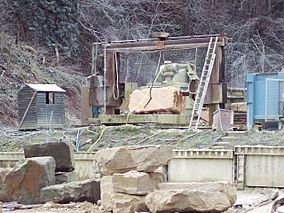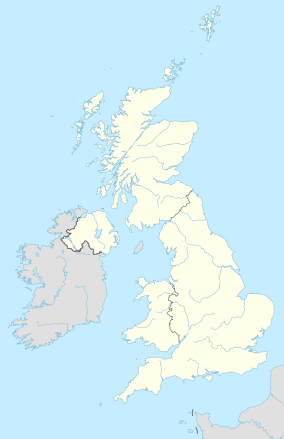Chilmark Quarries facts for kids
Quick facts for kids Chilmark Quarries |
|
|---|---|

Stone being worked at Chilmark, 2007
|
|
| Location | Wiltshire, South West, England |
| Area | 9.65 ha (23.8 acres) |
| Established | 1977 |
| Governing body | Natural England |
| Website | SAC at MAgiC |
Chilmark Quarries is a special place in Wiltshire, England. It covers 9.65 hectares, which is about 24 acres. This site is important for both its unique nature and its geology.
It was first recognized as a Site of Special Scientific Interest (SSSI) in 1977. Later, in 2005, it became a European Special Area of Conservation. This was mainly because it's a very important home for bats. The quarries are split between two villages: Chilmark and Teffont.
Contents
A Look Back: History of Chilmark Quarries
Chilmark stone is a type of limestone. People have been mining this stone since the Middle Ages. It was used to build many important structures. One famous example is Salisbury Cathedral.
In 1936, the Air Ministry bought the quarry and its mines. They used the area to store things for RAF Chilmark. This was a special depot for military supplies. The depot closed in 1995.
Stone mining continued on a small scale. The quarry then closed around 2007. However, in March 2019, Chilmark Stone (Properties) Ltd reopened the quarry. They started extracting stone again.
Why Are Bats Important Here?
The disused quarries on the western side of the valley have a system of caves. These caves are a winter home for many bats. Up to 150 bats of different types roost here.
The largest group of Bechstein's bats in Britain spends winter here. Other bat species also use this site. These include greater and lesser horseshoe bats. You might also find Daubenton's bats, Natterer's bats, and Brandt's bats.
The Amazing Geology of Chilmark Stone
The quarry shows off Jurassic rocks. These rocks are part of the Purbeckian beds. Chilmark stone is a very good building stone. It was used for the main structure of Salisbury Cathedral. Many other local buildings also feature this stone.
Ancient Uses of Chilmark Stone
People used Purbeckian limestones long ago. Some think it came from Chilmark. It was used to pack around stones at Stonehenge. Houses at an Iron Age site in Fifield Bavant also used it. Even Rockbourne Roman Villa and other Roman sites used this stone.
Chilmark stone is easy to work with. But it is also very strong and lasts a long time. You won't find many fossils in the stone being extracted now. However, some ammonites and other shells have been found.


